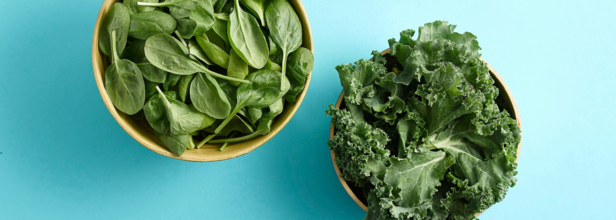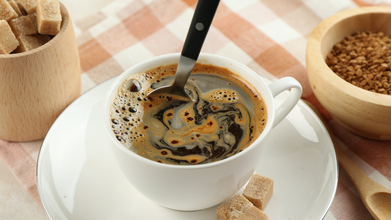- Health Conditions A-Z
- Health & Wellness
- Nutrition
- Fitness
- Health News
- Ayurveda
- Videos
- Medicine A-Z
- Parenting
- Web Stories
Kale Vs Spinach, Which One Should You Go For?

Credits: Canva
Leafy greens, we all know are one of the healthiest foods on the earth. It offers so much, the benefits are countless, whether it is brain health, heart health or to control your blood sugar levels. But there is always a debate between which one is better. Spinach or kale?
So let's get into it!
Kale, we often must have heard its name listed as a "superfood". The reason is because of the rich nutrients it has to offer. However, both, spinach and kale are powerhouse leafy greens, rich in various nutrients.
If one must break down its nutrients, then we can broadly divide it between the fiber content, vitamin K, vitamin C, vitamin A, calcium, and folate.
Fiber
All leafy greens are rich in dietary fiber and thus is essential for feeding your gut microbiome. This is the community of good bacteria that lives in your gut and supports your digestive health. The recommended daily amount or the RDA of fiber is 25 grams per day. So, if you go for a cup of raw spinach, this gives you around .7 grams of dietary fiber, whereas one cup of raw kale gives you a bit more. It has .9 grams of fiber.
A study published in M J Lifestyle Med titled . Closing America's fiber intake gap: Communication strategies from a food and fiber summit, found that most Americans actually do not get their RDA for fiber met. So, adding spinach and kale could be a great way to give your RDA fiber a start!
Vitamin K
Vitamin K is necessary for blood clotting or lowering blood flow following an injury so that the wound can heal. In addition to calcium and vitamin D, it also supports healthy bones. While some animal products and fermented foods include vitamin K2, a 2020 study titled Vitamin K2 needs an RDI separate from vitamin K1, notes that lush greens like spinach and kale have vitamin K1.
The recommended daily intake of vitamin K is 120 microgrammes (mcg). A cup of raw kale has 82 microgrammes of vitamin K, while a cup of raw spinach contains 145 microgrammes.
Vitamin C
It is a water-soluble vitamin and antioxidant that protect cells from damage and supports immune health. While it is often attributed to citrus fruits like oranges, vitamin C can also be found in leafy greens and both kale and spinach could be a great source. US Food and Drug Administration (FDA) recommends around 80 milligram of daily vitamin C. In one cup of raw spinach, you can get 8.5 milligrams, while kale provides 20 milligrams of daily vitamin C.
Vitamin A
As per the FDA, vitamin A is important not only for your immune system, but also for your eye health. One must have at least 3,000 international units daily. The Office of Dietary Supplements notes that spinach and kale contain compounds called carotenoids, which our bodies convert to a usable form of vitamin A. This way you can have these leafy greens in your diet to fulfill your requirement of vitamin A. In one cup of spinach, you can get 2,810 international units of vitamin A, whereas in one cup of kale, you will find 1,010 international units of vitamin A.
Calcium
Leafy greens are a rich source of calcium, an important nutrient which supports healthy bones and teeth, nerve communication, and muscle movement. The RDA for calcium in adults is 1,300 milligrams and one cup of raw spinach contains 30 milligrams of calcium, whereas in kale, it has 53 milligrams.
Folate
It is a B vitamin which is best known for its important in pregnancy and that provides neural tube defects like spina bifida in fetuses. The RDA for folate is 400 micrograms in pregnant mothers and 600 for those who are lactating. In one cup of spinach, one can get 58.2 micrograms of folate, whereas kale contains 13 micrograms of folate.
How to Decide Your Diet?
Now that you know the nutrients that kale and spinach contain, you make your own decision. This could be decided based on your requirement. The best way to do this is by talking to a healthcare expert, or a nutritionist who can recommend you better based on your body's need.
Christmas Dinner Could Disappear This Year Due To Bird Flu Outbreak In UK

Credits: Canva
Christmas dinners could 'disappear', all thanks to the bird flu outbreak across UK. This warning has come from a poultry farmer as the cases of bird flu have gone up from North Yorkshire, Lincolnshire, Devon, and East Sussex.
This warning came from farmer Andrew Goodman, who works at Goodman's Geese in Great Witley, Worcestershire, as reported in BBC. He said that the threat of bird flu infection was a "continual worry", especially when it is ahead of the festive period. He told BBC that a single outbreak of the disease could lead to 10,000 Christmas lunches to disappear.
"You're finished basically. If we got it, all the birds would be slaughtered on the farm and then, with our free-range system, you're not allowed to restock for 12 months. Which would mean no birds for Christmas next year."
What Is Bird Flu?
Bird flu spreads from bird droppings and saliva. This happens especially when they feed on birdfeed and water.
Authorities have expanded compulsory poultry housing measures—previously limited to the North, Midlands and East—to all of England starting Thursday, in an effort to curb disease transmission. A nationwide Avian Influenza Prevention Zone also remains in force, mandating stringent biosecurity and hygiene protocols.
Health and Me had earlier reported that the UK had ordered 5 million vaccines against bird flu, also dubbed as "one mutation from being the next COVID". The comparison of bird flu with COVID, comes from the mutation that has recently been seen in the avian flu, which has affected animals and humans alike. Similar to how the corona virus previously also mutated, and continues to do so.
What are the symptoms one must look out for?
- Pink eye
- fever
- fatigue
- cough
- muscle aches
- sore throat
- nausea
- vomiting
- diarrhea
- study or runny nose
- shortness of breath
Birds flu in humans
The first case of the recent bird flu outbreak in the US came in September, from a Missouri resident. However, the person did not have any exposure to infected animals. This is what is also raising the concern for mutation and the possibility of other forms of spreading. This was also a rare case as the infection did not happen due to exposure. Previously, all such cases in the US involved contact with farm animals or contaminated environment.
Can bird flu come from other animals?
Bird flu primarily infected farmworkers or those in close proximity to livestock. The first human bird flu case in the US was reported in 2022, to a person who was also involved in farm-working.
While this flu is largely confined to birds in the wild and poultry, recent outbreaks have been reported in mammals too, including cattle.
While 14 cases are in the US, the CDC notes that the risk to the general public is still at low, however, this warning could change. "Although human infections are rare, circumstances may evolve as we learn more about this case," said the CDC in a statement.
Is Instant Coffee Slowly Making You Lose Your Eye Sight? Researchers Find Concerning Link With Eye Health

(Credit-Canva)
New research is suggesting a significant connection between drinking instant coffee and a higher chance of getting age-related eye disorder.
Instant coffee may seem like a great way to start your day if you are in a hurry, however, a study has pointed out a major health consequence of drinking it. Published in the Food Science & Nutrition journal, this study showed that instant coffee could increase your risk of age-related macular degeneration (AMD).
Think of AMD as a common eye disease that can hurt your central vision and may even cause permanent blindness, especially for people over the age of 50.
Scientists did a study to look closely at how different types of coffee, ground, decaf, and instant, affect eye health. What they found was surprising. Earlier studies had actually hinted that coffee might be helpful for your eyes, possibly lowering the risk of AMD. However, this new research found the opposite was true for one type:
They discovered that only drinking instant coffee was clearly and strongly linked to an increased risk of getting dry AMD. In short, the study concluded that instant coffee "significantly increases the risk of AMD."
What is Macular Degeneration (AMD)?
The macula is a small spot right in the center of your retina (the light-sensitive layer at the back of your eye). It's crucial because it gives you your central vision, which you use for reading and seeing fine details. There are two main types of AMD:
Dry AMD
This is the most common type. It happens when tiny yellow protein deposits form under your macula, slowly making your central vision blurry.
Wet AMD
This is less common but more serious. It happens when abnormal, fragile blood vessels grow under the macula and leak fluid and blood, causing quick damage.
You are more likely to develop AMD if you smoke, are overweight, have high blood pressure, or if someone in your immediate family has the disease.
How Does Instant Coffee Affect Eye Sight?
Since ground and decaf coffee didn't show this same risk, the researchers believe the difference has something to do with how instant coffee is made.
They suggest that the manufacturing process, which is different from brewing regular coffee, might be creating certain "potentially harmful substances" or involves additives that are not present in other types of coffee. Because of these findings, the researchers give a clear warning: if you are already at high risk for AMD, it's a good idea to avoid drinking instant coffee.
How Is Age-Related Macular Degeneration Treated?
The National Health Services UK explain that there is no cure for AMD right now. However, there are treatments and support available to help slow down vision loss and ensure you can maintain the best possible quality of life.
Your treatment plan will depend on the type of AMD you have, wet or dry. You will work with eye doctors, such as an optometrist, who checks eyes and an ophthalmologist who treats eye diseases.
Treatments for Wet AMD
Wet AMD happens when abnormal, fragile blood vessels start leaking fluid and damaging the eye. The main goal of treatment is to stop these leaks. Doctors use eye injections (called anti-VEGF) of medicine directly into the eye to block the growth of the bad blood vessels, or sometimes use light treatment to destroy them.
Treatments for Dry AMD
Unfortunately, there's currently no medical cure to reverse or stop dry AMD with medicine or surgery. Treatment focuses on supporting your remaining vision. Specialists offer low vision help by teaching you to use tools like bright lights and magnifiers. They also recommend lifestyle changes like specific diets and habits to protect your eye health.
Drinking Energy Drinks Often? Your Heart And Brain May Pay The Price

Credits: Canva
Energy drinks have become a common pick-me-up, marketed as quick fixes for sharper focus, improved alertness, and instant energy. Whether you are working late or driving for hours, grabbing a can may feel like the easiest way to stay awake. Yet once that caffeine rush fades, what lasting effects does it leave on your heart, brain, and sleep?
The FDA has received several reports connecting energy drink intake to deaths and serious side effects such as spikes in blood pressure, seizures, and irregular heart rhythms. Many of these incidents required hospital treatment.
Between 2022 and 2023, America’s Poison Centers recorded a 24.2% rise in cases of children and teenagers under 20 being exposed to energy drinks. Worryingly, around 78% of these were accidental, most youngsters did not realize how much caffeine they were consuming or even that their drink contained it.
How Energy Drinks Can Overstimulate Your Heart
Studies have shown that energy drinks can disrupt normal heart rhythm. People who consume them often experience higher blood pressure and irregular heart activity that can last for several hours, which may increase the chance of dangerous arrhythmias.
Caffeine stimulates the sympathetic nervous system, raising heart rate and blood pressure. But unlike coffee, energy drinks combine caffeine with other stimulants such as guarana, taurine, and L-carnitine, which amplify caffeine’s impact, according to researchers at Jefferson Health.
They also note that one can of an energy drink may contain far more caffeine than a standard 8-ounce cup of coffee. The FDA generally considers up to 400 milligrams of caffeine a day to be safe for healthy adults with no heart problems.
Although experts points out that the caffeine difference between coffee and energy drinks may not appear large, labels can be misleading. A cup of coffee contains about 90 mg of caffeine, while energy drinks can range from 100 to 350 mg, sometimes even more when a single can holds multiple servings. Reading labels carefully helps you understand how much caffeine you are really consuming.
Energy Drinks Contain Excess Calories
Along with caffeine, these drinks are often loaded with sugar and calories. Many specialty coffees, packed with syrups, whipped cream, and heavy dairy, fall into the same category. Regularly consuming such beverages increases the risk of weight gain, obesity, and type 2 diabetes, all of which harm heart health.
Dr. Reginald Ho, a cardiologist, explains that over time, this pattern can lead to high blood pressure, rapid heartbeat, and other cardiovascular diseases.
Energy Drinks Can Lead to Stroke Issues
Energy drinks may also raise the risk of stroke. A stroke is often described as a “heart attack in the brain.” One condition linked to these drinks is reversible cerebral vasoconstriction syndrome (RCVS), which involves sudden spasms in the brain’s blood vessels that can either restrict blood flow or cause bleeding, as noted by the Cleveland Clinic.
Caffeine blocks adenosine, the chemical that helps the brain relax, so even when you feel tired, your mind remains overstimulated. This disruption affects your sleep cycle and can cause poor memory, low concentration, mood swings, anxiety, and even depression.
Can You Mix Energy Drinks With Alcohol?
Health experts have repeatedly warned against mixing alcohol with energy drinks. The FDA has stated that adding caffeine to alcohol makes for an “unsafe additive.”
Caffeine’s stimulant effect masks alcohol’s depressant properties, allowing people to drink more without feeling its sedative impact. This can lead to misjudging one’s level of intoxication and even driving while impaired.
While energy drinks may promise a quick fix for fatigue, their risks to the heart, brain, and sleep are real. Choosing natural ways to stay energized, through rest, hydration, and balanced nutrition, is far better for long-term health.
© 2024 Bennett, Coleman & Company Limited

